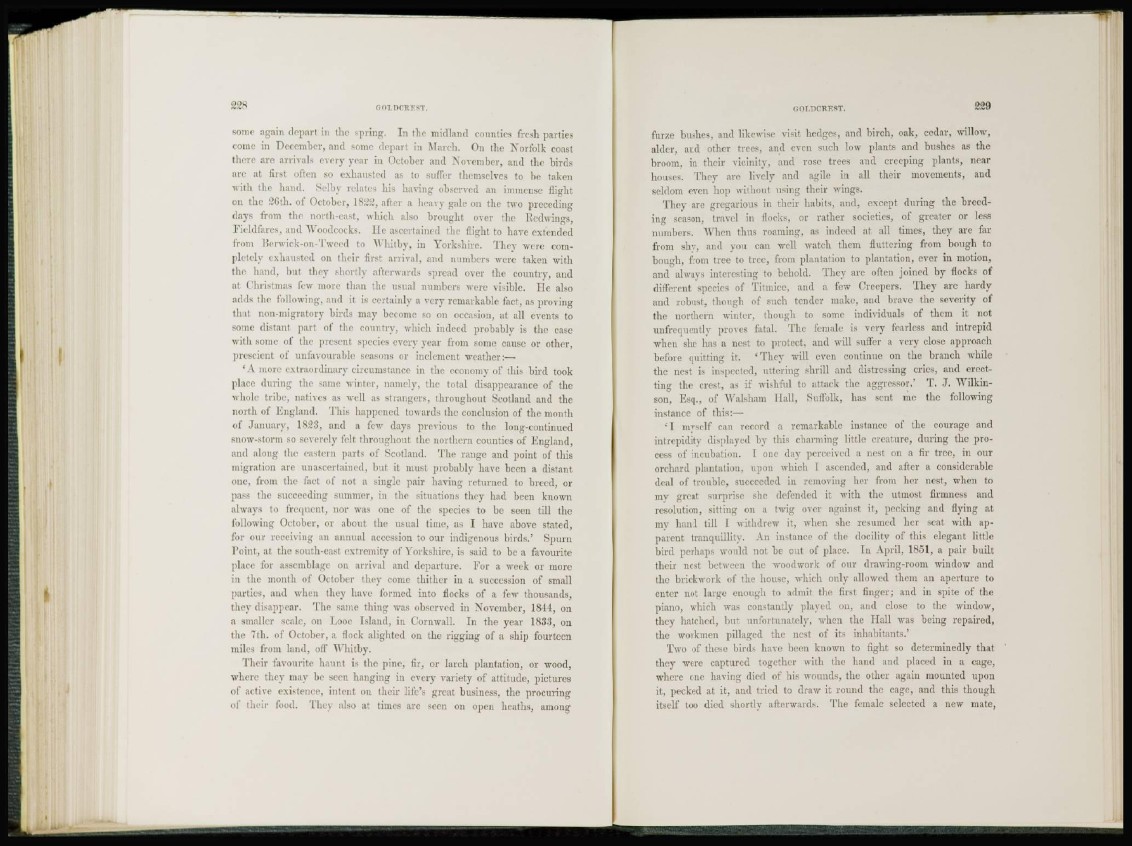
GOLDCXEBT
some again depart in the spring. In the midland counties fresh parties
come in December, and some depart in March. On the Norfolk coast
there are arrivals every year in October and November, and the birds
are at first often so exhausted as to suffer themselves to be taken
with the hand. Selby relates his having observed an immense flight
on the 26th. of October, 1822, after a heavy gale on the two preceding
days from the north-east, which also brought over the Redwings,
Fieldfares, and Woodcocks. He ascertained the flight to have extended
from Berwick-on-Tweed to Whitby, in Yorkshire. They were completely
exhausted on their first arrival, and numbers were taken with
the hand, but they shortly afterwards spread over the country, and
at Christmas few more than the usual numbers were visible. He also
adds the following, and it is certainly a very remarkable fact, as proving
that non-migratory birds may become so on occasion, at all events to
some distant part of the country, which indeed probably is the case
with some of the present species every year from some cause or other,
prescient of unfavourable seasons or inclement weather:—
' A more extraordinary circumstance in the economy of this bird took
place during the same winter, namely, the total disappearance of the
whole tribe, natives as well as strangers, throughout Scotland and the
north of England. This happened towards the conclusion of the month
of January, 1823, and a few days previous to the long-continued
snow-storm so severely felt throughout the northern counties of England,
and along the eastern parts of Scotland. The range and point of this
migration are unascertained, but it must probably have been a distant
one, from the fact of not a single pair having returned to breed, or
pass the succeeding summer, in the situations they had been known
always to frequent, nor was one of the species to be seen till the
following October, or about the usual time, as I have above stated,
for our receiving an annual accession to our indigenous birds.' Spurn
Point, at the south-east extremity of Yorkshire, is said to be a favourite
place for assemblage on arrival and departure. For a week or more
in the month of October they come thither in a succession of small
parties, and when they have formed into flocks of a few thousands,
they disappear. The same thing was observed in November, 1 8 4 4 , on
a smaller scale, on Looe Island, in Cornwall. In the year 1833, on
the 7th. of October, a flock alighted on the rigging of a ship fourteen
miles from land, off Whitby.
Their favourite haunt is the pine, fir, or larch plantation, or wood,
where they may be seen hanging in every variety of attitude, pictures
of active existence, intent on their life's great business, the procuring
of their food. They also at times are seen on open heaths, among
noT-DcnnsT.
furze bushes, and likewise visit hedges, and birch, oak, cedar, willow,
alder, and other trees, and even such low plants and bushes as the
broom, in their vicinity, and rose trees and creeping plants, near
houses. They are lively and agile in all their movements, and
seldom even hop without using their wings.
They are gregarious in their habits, and, except during the breeding
season, travel in flocks, or rather societies, of greater or less
numbers. When thus roaming, as indeed at all times, they are far
from shy, and you can well watch them fluttering from bough to
bough, from tree to tree, from plantation to plantation, ever in motion,
and always interesting to behold. They arc often joined by flocks of
different, species of Titmice, and a few Creepers. They are hardy
and robust, though of such tender make, and brave the severity of
the northern winter, though to some individuals of them it not
unfrequentlv proves fatal. The female is very fearless and intrepid
when she has a nest to protect, and will suffer a very close approach
before quitting it. ' They will even continue on the branch while
the nest is inspected, uttering shrill and distressing cries, and erectting
the crest, as if wishful to attack the aggressor.' T. J . Wilkinson,
Esq., of AValsham Hall, Suffolk, has sent me the following
instance of this:—
eI myself can record a remarkable instance of the courage and
intrepidity displayed by this charming little creature, during the process
of incubation. I one day perceived a nest on a fir tree, in our
orchard plantation, upon which I ascended, and after a considerable
deal of trouble, succeeded in removing Inn' from her nest, when to
my great surprise she defended it with the utmost firmness and
resolution, sitting on a twig over against it, pecking and flying at
my hand till I withdrew it, when she resumed her seat with apparent
tranquillity. An instance of the docility of this elegant little
bird perhaps would not be out of place. In April, 1851, a pair budt
their nest between the woodwork of our drawing-room window and
the brickwork of the house, which only allowed them an aperture to
enter not large enough to admit the first finger; and in spite of t he
piano, which was constantly played on, and close to the window,
they hatched, but unfortunately, when the Hall was being repaired,
the workmen pillaged the nest of its inhabitants.'
Two of these birds have been known to fight so determinedly that
they were captured together with the hand and placed in a cage,
where one having died of his wounds, the other again mounted upon
it, pecked at it, and tried to draw it round the cage, and this though
itself too died shortly afterwards. The female selected a new mate,